
Ruth Miller grew up in a household where social justice and family ancestry were common topics at the dinner table. Born in Anchorage, Alaska as a member of the Dena’ina Athabascan tribe and the Ashkenazi Jewish faith, she was raised by parents — both indigenous rights lawyers — to understand at an early age how human rights and her heritage intersect with the landscape around her.
“Having the opportunity to grow up in my territory gave me access to the forest, the mountains, and the water, and really gave me a sense of responsibility for the environment and the importance of cohabitation with the natural world,” Ruth says. “I grew up totally steeped in my Native values, which are based on a community and a land that is fundamentally indigenous.”
Today, Ruth is standing up for indigenous-led climate justice. This month, she will represent the United Nations Association of the United States (UNA-USA) at the UN Permanent Forum on Indigenous Issues in New York. In this way, she is continuing a family legacy started by her paternal grandmother, who spent much of her life actively engaging with the United Nations — first by presiding over UNA-USA’s New York Chapter in the mid-1980s, and later serving as a member of the National Council of UNA-USA.
We interviewed Ruth as part of our Protectors of Progress series, which highlights the stories of everyday individuals across the globe who are stepping up in their communities to help realize the promise of the Sustainable Development Goals (SDGs), a global roadmap for the future adopted by all UN member states in 2015. While there is a lot of work to be done to achieve the SDGs, advocates like Ruth show that it’s possible to protect — and advance — progress when we take action.
Earlier this year, you were one of three people selected from an audience of nearly 2,000 young Americans to personally address the UN Secretary-General at UNA-USA’s Global Engagement Summit. You chose to ask about climate justice. Why did you choose that particular question?
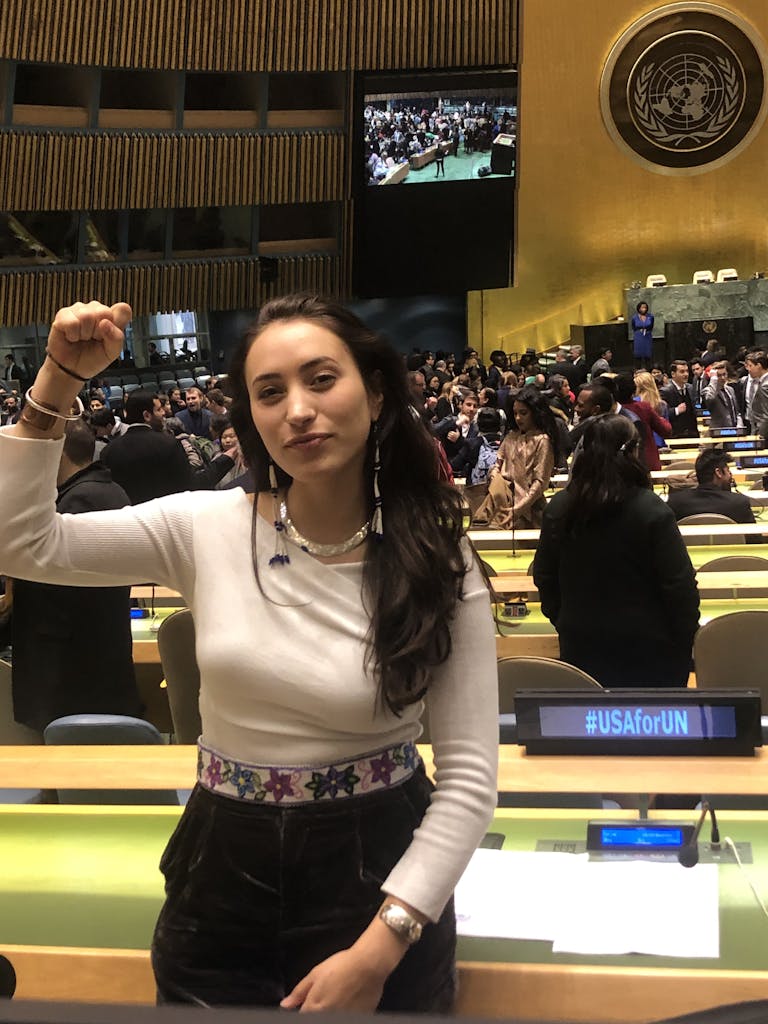 Ruth Miller: I think climate change is the most pressing issue that faces not only this country and my people, but the world today. It has the potential to have disastrous consequences, but also offers the opportunity for momentous social movements.
Ruth Miller: I think climate change is the most pressing issue that faces not only this country and my people, but the world today. It has the potential to have disastrous consequences, but also offers the opportunity for momentous social movements.
And climate justice should include first and foremost the voices of the people who will be affected by climate change the most, and I do not see that happening in the majority of international rhetoric at the moment.
So when I had the opportunity to ask the UN Secretary-General a question, I felt that this question not only pertained to the global situation — which will impact every global citizen — but it also pertained to the people at the bottom of the rung, who will face the impacts the most acutely and who have historically had the least amount of global support.
Because when I think of climate change and climate justice, I’m not thinking about environmental law or international economic forces. I’m thinking about my family. I’m thinking about my community. I’m thinking about the people I know in my life who depend on natural resources — not for profit, but for survival, for subsistence, in addition to cultural preservation.
And I cannot think of a more pressing global issue that encompasses both the economic relationships of our world, the social relationships of our world, and the preservation of our planet.
Tell us about your experience at the Global Engagement Summit. Why do you think organizations like UNA-USA are so important for raising the voices of indigenous communities and young people?
I found out about the UNA-USA Global Engagement Summit through a chance email. It was an item on a bulletin that was posted to my department here at Brown University. And when I decided to register, I was thinking what an opportunity it would be to learn about human rights and international discourse, and also how youth can become engaged in these conversations.
What was much more impressive to me was the tone of the conversations once I arrived at the summit. Having the opportunity to pose a question to the UN Secretary-General was an extraordinary experience, but what has been more gratifying to me has been the conversations that have come since then. Having the opportunity to give interviews such as this, to speak with students about climate justice in their communities, people who have come up to me since then and began talking to me about opportunities for collaboration.
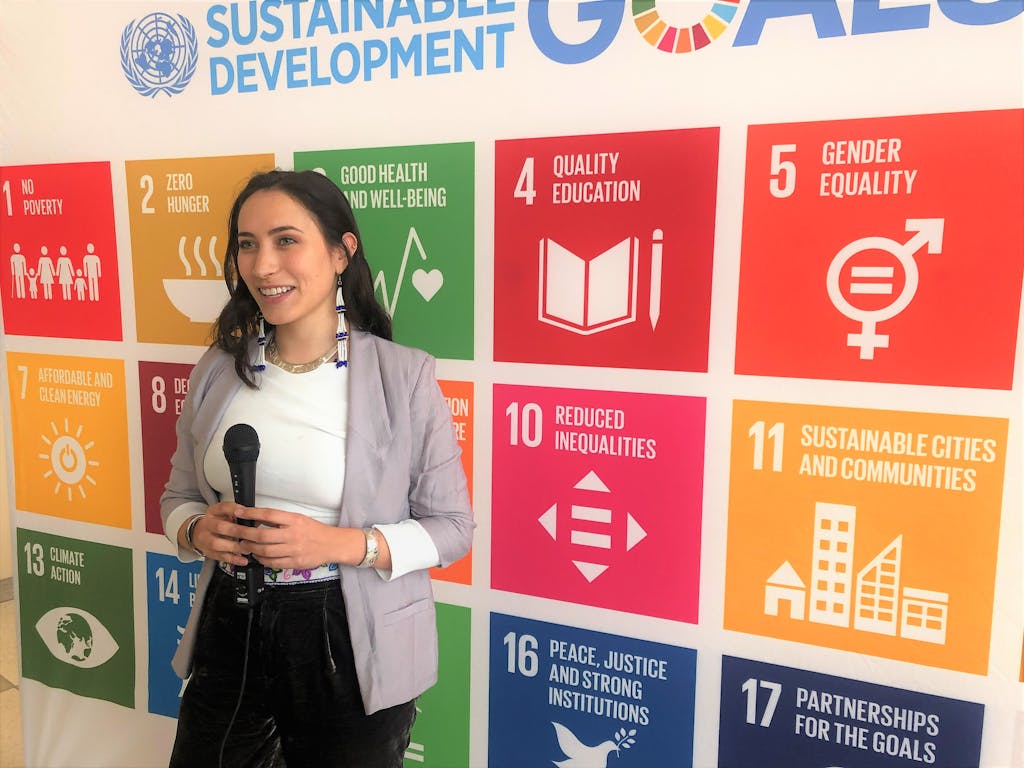
However, I have to say that I am immensely privileged. I am a mixed-race Native person who is attending an Ivy League university on the East Coast. I have the time to travel to New York to attend the summit for a weekend. When we’re talking about uplifting voices, mine is only one of many that should be centered in these discussions.
And while I am honored and proud that I had this opportunity to speak and to represent my community and the communities that I stand in solidarity with, it is not nearly enough. I don’t think these organization will achieve all that they could unless they expand these conversations and engage those who couldn’t easily make it to New York for a weekend.
Today, there are more than 370 million indigenous people in 70 countries worldwide. On April 22nd — Earth Day — the UN will convene its annual forum on indigenous issues at its headquarters in New York. The two-week session will address challenges and opportunities across a broad range of sectors, from economic and social development to education and the environment. As UNA-USA’s official representative, Ruth will be among hundreds of Native leaders, experts, and activists whose voices will be heard on the international stage.
What are you hoping to say at the UN Permanent Forum on Indigenous Issues? What do you hope to take away?
I hope to emphasize the role of youth in pursuing political and social change for indigenous peoples. In many of our cultures, we think generationally, and it was a crucial tradition that youth should learn to lead from their elders, and be trusted with responsibility from a young age.
In this new age of technology and social media, indigenous youth are best prepared to begin leading the change that will bring our communities into this next era. I also hope to emphasize the importance of cross-cultural collaboration between different indigenous communities. Our nations are vibrant and strong, and we only will grow stronger through collaboration and communication.
I believe that global indigenous networking is our future. I know that the lessons I will receive from other representatives and other communities will be invaluable, and I am certain it will broaden my understanding of potential for collaboration.
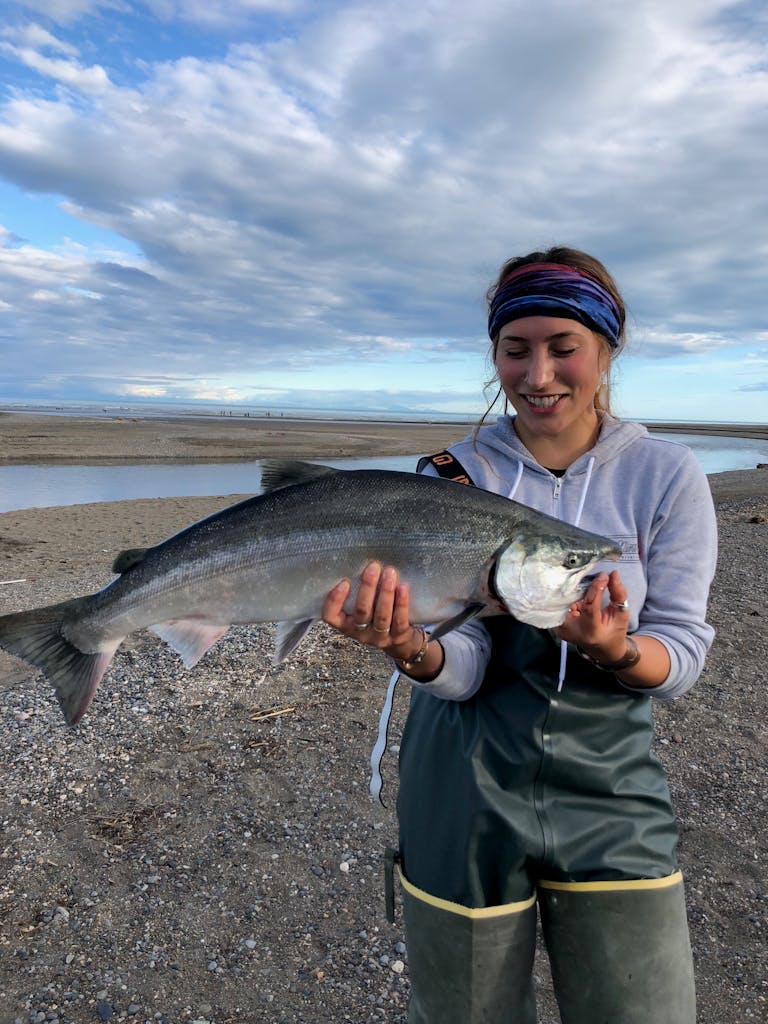
From your perspective, how have you seen climate change affecting Native American communities in Alaska?
Native people, to this day, fundamentally live off the land. We depend on consistent migration patterns of caribou herds. We depend on the timing of the salmon runs to our bays and to our rivers. We notice when the permafrost is melting earlier. We notice when the weather patterns are changing because it affects the food that we gather for our communities. And so when harvests are coming at different times each year, when development projects are taking precedence over the importance of maintaining subsistence lifeways, Native people notice.
One example — it actually became a court case that was argued by the Native Americans Rights Fund about 10 years ago — was in the Village of Kivalina, where families in a Native village had become environmental refugees. They had to be relocated because the changing weather patterns and the changing temperatures along the coastline meant that sea ice was melting and no longer protecting their village from winter storms. This meant the land they had ancestrally occupied for thousands and thousands of years was falling into the water. And the state and federal governments were not providing them adequate resources to relocate away from the lands that they had lost.
Right now, one of the most pressing issues in Alaska is the opening of the Arctic Natural Wildlife Refuge. There are a number of development corporations backed by the Trump Administration that are intent on opening up the wildlife refuge to resource extraction and exploitative development projects. And it has been concluded, not only by Native people, but by scientists, that these development projects would fundamentally jeopardize the sustainability of the ecosystem of the area.
This refuge is one of the largest and most pristine wildlife areas in the country. Oil drilling would cause devastating effects that would be irreversible should this development be allowed. One of the largest caribou herds, the Porcupine Caribou Herd, is active in this refuge, which the Gwich’in people of the area still rely on for food.
So climate change is not just about the global temperature going up a few degrees. Climate change is about a fundamental disrespect and degradation of our environment that leads to acute and violent effects for indigenous people.
Discussions on climate change tend to focus on the economic impact or the consequences on human health. How do you see climate change also affecting biodiversity, and how does that relate to indigenous views of the land?
I think that to sustainably live with the land, there’s an understanding, a tradition, that you take what you need and give back all that you can. Every indigenous culture that I’ve encountered deeply believes in the practice of using every aspect of every animal that is taken, every aspect of every tree that is taken. You will not find a single bone unbroken when you are done processing an animal.
And what accompanies that is a consciousness of when you take too much. I think that from an indigenous perspective, one of the most crucial pieces of our ideology is balance and respect. That is not something that you see in the ethos of extracted development projects.
Profiteering and the privatization of our world’s natural resources has led to a serious exploitation of our lands and waters, the effects of which have fallen acutely on the shoulders of the people who depend on those lands and waters for subsistence.
If we’re talking about biodiversity, we’re talking about respecting the earth and cohabitating with it in a way that will allow future generations to also subsist off that land, to also sustain themselves with those waters. That type of long-term perspective of preservation and conservation is not present in short-term monetary gain.
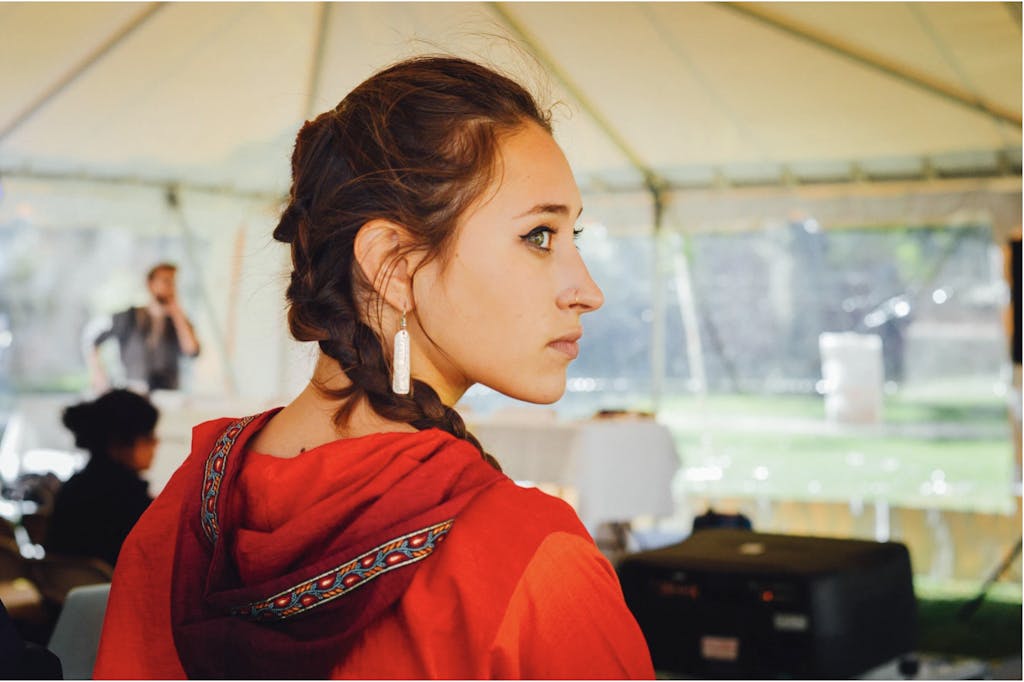
Ruth’s journey to advocacy began at a young age. Growing up, she had the opportunity to travel with her parents and learn firsthand about the shared values and cultural differences of other tribal communities in Alaska like the Tlingit, Eyak, Yup’ik, Cup’ik, and Iñupiaq, as well as indigenous communities in Chile, Nepal, and Jordan. These experiences helped deepen her perspective on the power of collective action and how she could act not only in defense of her own community, but also in solidarity with others. “This lesson was a core part of my upbringing,” she says. At 16, she started interning for former U.S. Senator Mark Begich, becoming one of the youngest interns on Capitol Hill.
That was my first introduction to not only how a young person could get involved in political advocacy within government, but it also exposed me to the many different platforms that indigenous advocacy can take. I had the opportunity to work on bills that allowed for traditional foods to be served in public centers, for example. But it also gave me access to different types of conversations that were happening on Capitol Hill.
Soon after that, I began working for United Tribes of Bristol Bay, which is an advocacy consortium of 15 regional tribes based out of Dillingham, Alaska, whose work is prominently in environmental protection of the region, because indigenous rights are environmental rights and environmental rights are indigenous rights. This organization was mobilizing against Pebble Mine, which is a proposed copper mine in the regional watershed that would have disastrous consequences on the last great salmon fishery in the world. United Tribes of Bristol Bay has been one of the leading organizations to advocate against this permitting process.
When I was there in Dillingham, part of the time I was in an old, condensed storage unit talking to fishermen passing through the harbor, trying to increase awareness about the threat that they were facing, not only to their food, but to their livelihoods — because 14,000 jobs are supported by the salmon industry in the area, and all of those would be jeopardized by this polluting mine.
I also had the opportunity to be involved with Environment Protection Agency hearings in the area. I got to help local community residents create their testimonies to offer to the EPA.
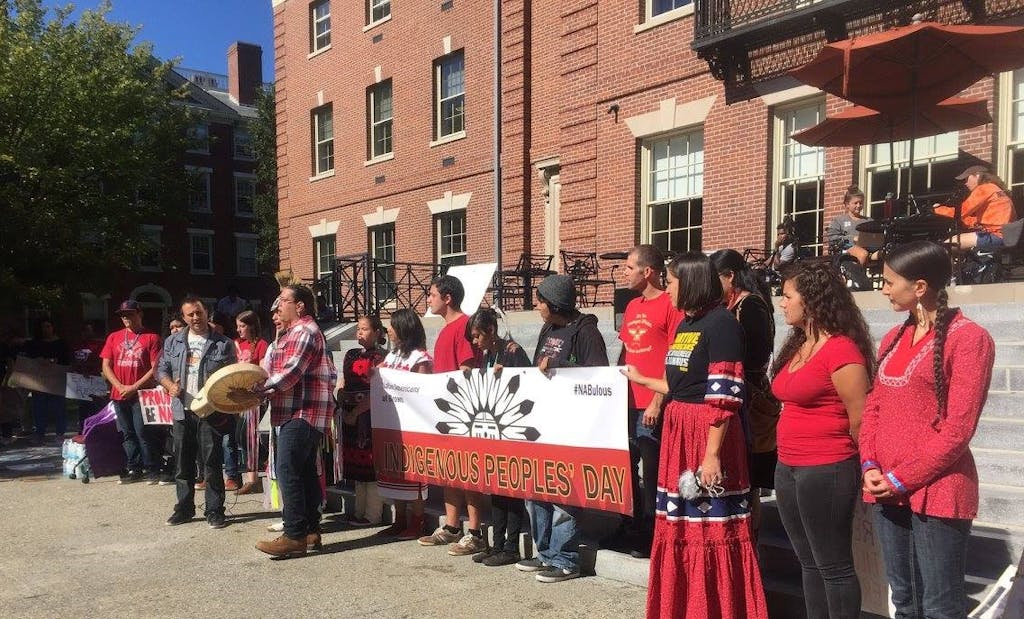
How did your advocacy work evolve when you moved to the East Coast to attend college?
It was here at Brown University that I began getting involved with a trans-indigenous community, as I would call it, which includes individuals from all over the country and all over the Western Hemisphere. This was one of the first opportunities I had to really come together with other indigenous students and talk about not only our shared history, but our cultural differences.
We lobbied the university to change what had been formerly known as Columbus Day to Indigenous Peoples’ Day. We were able to establish the beginnings of a Native Studies Department here. And of course, we run our annual Powwow. That that was my first introduction to building and mobilizing an indigenous community.
During my sophomore year, I became the co-president of Native Americans at Brown and it was that year that I organized 11 of us to travel to Standing Rock, North Dakota to stand with the Water Protectors at the Oceti Sakowin Camp. That was one of the most profound experiences of my life.
One of the challenges facing the UN and its partners is getting grassroots advocates like you to take up the Sustainable Development Goals as their own and really work to achieve them in their own communities. What is your perspective on that?
I think that it is less important to teach people about the Sustainable Development Goals and more important to remember that power lies with them. Fundamental change begins with the very, very small. If we’re committed to bringing those moments to a global scale, the change has to start on an individual level. It has start within our families. It has to start within our homes and our communities. If we can mobilize our collective power as people, and not as nations, or not as governments, then the change that we could realize would echo to the United Nations and beyond.
I think it’s also important to say that it’s not the individuals at the bottom who have brought the world into this crisis. Therefore, it’s not the behavior of the individuals at the bottom that needs to be modified. The world is at this breaking point — from an economic perspective, from a global warfare perspective, from a climate change perspective — because of the few people who are in power and the few corporations that have built their profits through the exploitation of the many. So if we’re talking about reform, if we’re talking about change, it’s not the responsibility of the individuals who have been victimized by these global processes.
These Sustainable Development Goals, as I understand them, were created to form a collective commitment to improving our world. And I think that to achieve them, we have to first remember that we gain power and we gain strength and we gain resilience from one another. And so that means encouraging equality and equity within your community. It means pursuing social justice when you have an opportunity to stand up and speak out.
Take Action
Inspired by Ruth’s story? Join the UNA-USA movement and support the UN’s mission to advance global progress, promote peace and security, and protect human rights at home and abroad.
Write to your member of Congress and tell them why a healthy planet is a top priority. Together, we can take climate action and achieve the Sustainable Development Goals.
Learn More
Discover more Protectors of Progress stories and nominate someone who inspires you.




 View All Blog Posts
View All Blog Posts